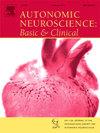Mechanism of heat treatment on exercise pressor reflex in hindlimb ischemia-reperfusion: Does the temperature gradient matter?
IF 3.3
4区 医学
Q2 NEUROSCIENCES
引用次数: 0
Abstract
Purpose
To examine the effect of heat treatment (HT) with two temperature gradients in skeletal muscle: 1.5 and 3 °C, on the exercise pressor reflex (EPR) responses following limb ischemia-reperfusion (IR). Specifically, the involvement role of the P2Xs (receptors of ATP) pathway in the muscle afferent neurons was accessed.
Methods
An experimental IR model was induced by 6 h of ischemia followed by 18 h of reperfusion in rats (IR rats). For HT groups, three HT sessions (muscle temperature increased by 1.5 or 3 °C) lasted for 30 mins each were applied. EPR responses were evoked by static muscle contraction (30s). Protein expression of P2X3 receptor in dorsal root ganglions (DRGs) was evaluated by western blot. In addition, a calcium imaging study was applied to detect calcium influx induced by activation of P2X3 in the isolated muscle DRG neurons of studied animal groups. Data are presented as mean ± standard deviation (M ± SD).
Results
The mean arterial pressure (MAP) response to the static muscle contraction was significantly exaggerated in rats of IR 18 h (vs. sham, p < 0.01). The exaggerated BP response was attenuated with increasing Tm by 1.5 and 3 °C (vs. IR, p < 0.05). The expression of the P2X3 receptor was significantly enhanced in the DRGs of IR 18 h rats (vs. sham, p < 0.01). The upregulated P2X3 was suppressed in the DRGs of IR 18 h rats +HT of 1.5 °C and 3 °C (vs. IR, p < 0.05). In the isolated muscle afferent neurons, the Ca2+ entry induced by extracellular application of α,β-Me-ATP (30 μM) were significantly increased in IR rats (vs. sham, p < 0.001). Both HT protocols suppressed the enhanced IR-induced Ca2+ entry (vs. IR, p < 0.001). There was no difference between the BP responses in HT1.5 °C and 3 °C groups, nor P2X3 expression in muscle afferent DRG, P2X-mediated Ca2+ entry in isolated muscle afferent neurons (all p > 0.05).
Conclusion
IR injury leads to upregulation of EPR responses, and HT attenuates this effect. The P2X3 signaling pathway was involved in the beneficial regulatory effect of HT on EPR in IR. The temperature gradient did not play a role in the extent of BP and muscle afferent P2X pathway activity attenuation in the present study.
热处理对后肢缺血-再灌注运动压力反射的影响机制:温度梯度是否有影响?
目的探讨骨骼肌温度梯度1.5℃和3℃热处理对肢体缺血再灌注(IR)后运动加压反射(EPR)反应的影响。具体来说,P2Xs (ATP受体)通路在肌肉传入神经元中的参与作用被访问。方法采用缺血6 h再灌注18 h的方法建立IR大鼠模型。高温组,肌肉温度分别升高1.5°C或3°C,每次持续30分钟。静肌收缩(30s)诱发EPR反应。western blot检测P2X3受体在大鼠背根神经节(DRGs)中的蛋白表达。此外,应用钙显像研究检测P2X3在研究动物组离体肌肉DRG神经元中激活引起的钙内流。数据以均数±标准差(M±SD)表示。结果IR 18 h大鼠对静态肌肉收缩的平均动脉压(MAP)反应显著升高(与假手术相比,p <;0.01)。随着温度升高1.5°C和3°C,夸大的BP反应减弱(相对于IR, p <;0.05)。P2X3受体在IR 18 h大鼠DRGs中的表达显著增强(与sham相比,p <;0.01)。上调的P2X3在IR 18 h大鼠+ 1.5°C和3°C的DRGs中被抑制(与IR相比,p <;0.05)。在离体肌肉传入神经元中,细胞外施加α,β-Me-ATP (30 μM)诱导的Ca2+进入在IR大鼠中显著增加(与sham相比,p <;0.001)。两种HT方案都抑制了增强的IR诱导的Ca2+进入(vs. IR, p <;0.001)。HT1.5°C和3°C组的BP反应没有差异,肌肉传入DRG中P2X3的表达也没有差异,p2x介导的Ca2+进入在离体肌肉传入神经元中也没有差异(均p >;0.05)。结论ir损伤可导致EPR反应上调,而HT可减弱这一作用。P2X3信号通路参与了HT对IR中EPR的有益调节作用。在本研究中,温度梯度对血压和肌肉传入P2X通路活性衰减的程度没有影响。
本文章由计算机程序翻译,如有差异,请以英文原文为准。
求助全文
约1分钟内获得全文
求助全文
来源期刊
CiteScore
5.80
自引率
7.40%
发文量
83
审稿时长
66 days
期刊介绍:
This is an international journal with broad coverage of all aspects of the autonomic nervous system in man and animals. The main areas of interest include the innervation of blood vessels and viscera, autonomic ganglia, efferent and afferent autonomic pathways, and autonomic nuclei and pathways in the central nervous system.
The Editors will consider papers that deal with any aspect of the autonomic nervous system, including structure, physiology, pharmacology, biochemistry, development, evolution, ageing, behavioural aspects, integrative role and influence on emotional and physical states of the body. Interdisciplinary studies will be encouraged. Studies dealing with human pathology will be also welcome.

 求助内容:
求助内容: 应助结果提醒方式:
应助结果提醒方式:


